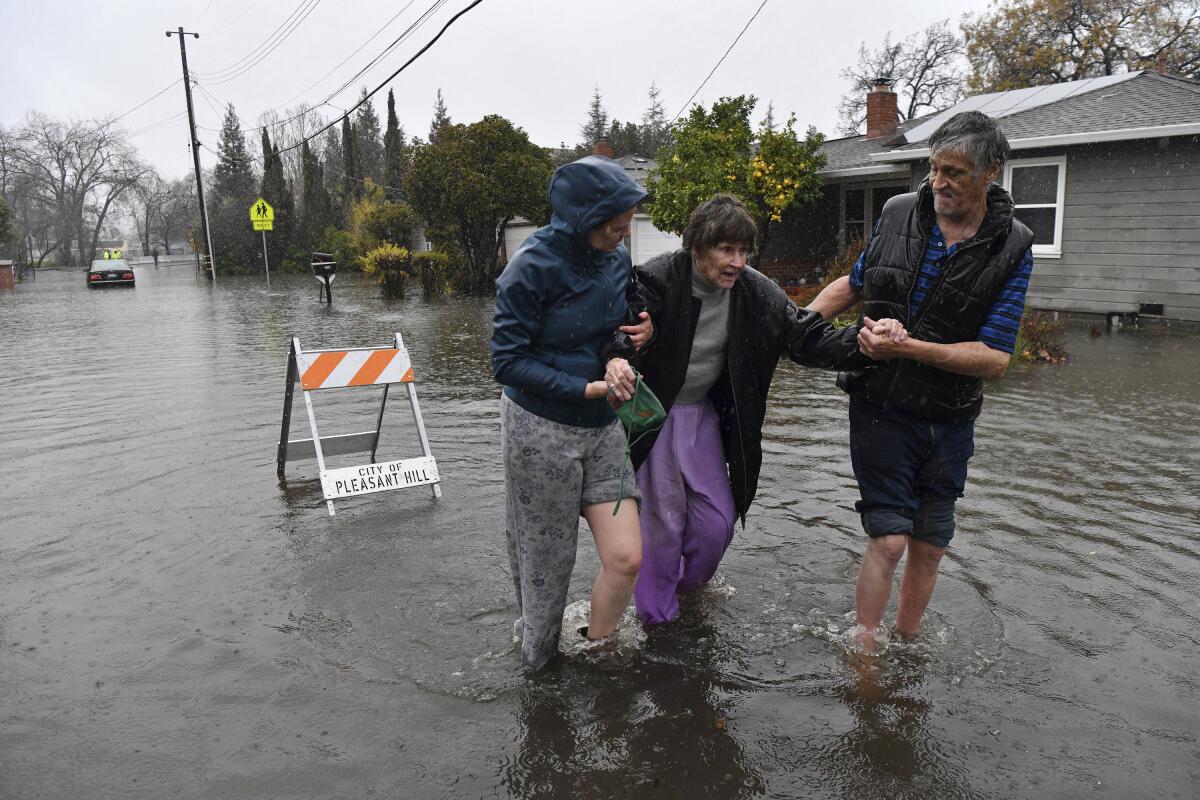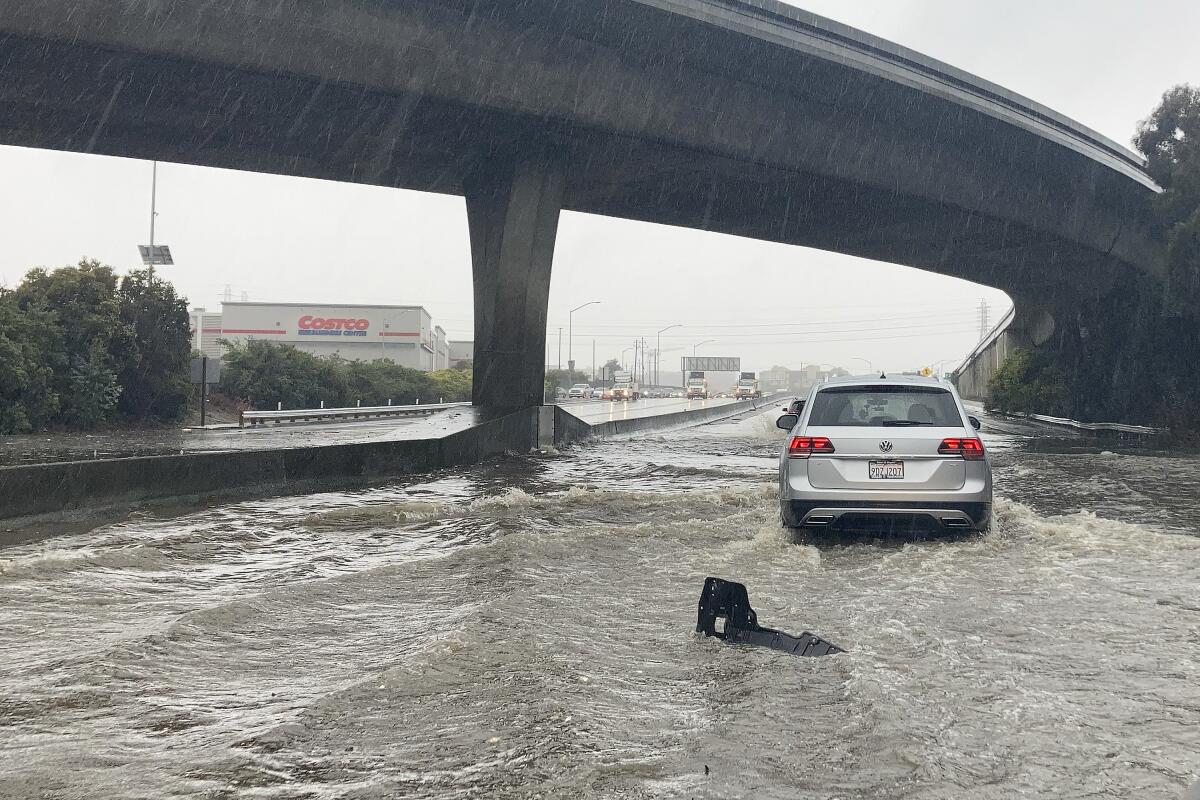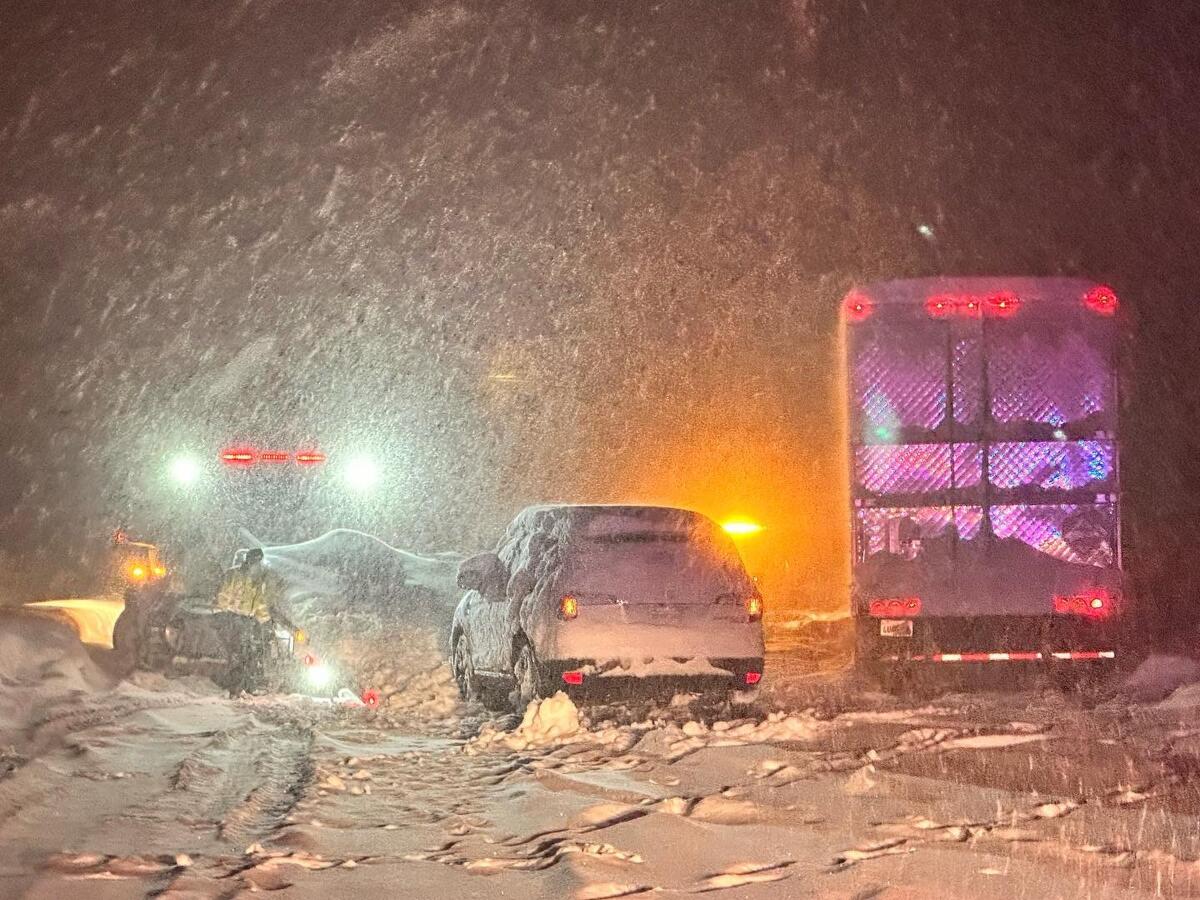Deadly storm pummels Northern California, breaching levees, forcing many water rescues

- Share via
After a powerful New Year’s Eve storm triggered landslides, blackouts and road closures across California, residents were left to deal with the aftermath Sunday as forecasters warned of even more rain in the coming days.
The heavy wind and downpours left tens of thousands of homes in Northern California without power for much of Sunday, while record high waters on the Cosumnes River near Sacramento breached three levees and inundated the area.
Flash flooding along Highway 99 and other roads south of Sacramento submerged dozens of cars near Wilton, where the water poured over the levees. Search and rescue crews in boats and helicopters scrambled to pick up trapped motorists. At least one person was found dead in a submerged car near Dillard Road and Highway 99, according to local media reports.
“I don’t want to use the term apocalyptic, but it’s ugly,” Sacramento County spokesman Matt Robinson said by phone from a stretch of Highway 99 that he described as a vast lake. “We have a lot of stuck cars.”
Downed power lines and trees crashing into homes created further trouble, said Capt. Parker Wilbourn of the Sacramento Metropolitan Fire District.
“It was an extremely busy night,” he said.
Electricity remained cut off midday Sunday for more than 32,000 customers, down from more than 100,000 who lost power overnight around Sacramento. The county warned Sunday afternoon that the floodwaters were rising around Highway 5 near the southern edge of Sacramento’s suburbs.
By late afternoon, as waters rose in the Cosumnes and Mokelumne rivers, authorities issued a mandatory evacuation order for the community of Point Pleasant, south of Elk Grove.
“Please be out of the area and off the roads while there is still light to reasonably see any danger,” Sacramento officials wrote in a message on Twitter. “Take the ‘5 P’s’ with you: People, Pets, Prescriptions, Paperwork and Photos.”
An evacuation center was set up at Wackford Center on Bruceville Road in Elk Grove. “Flooding in the area is imminent,” officials warned. “Floodwaters become incredibly dangerous after sunset.”
Some sunny skies offered much of the state a respite Sunday from the downpours, but another atmospheric river was barreling across the western Pacific and was set to drench California in the days ahead.
Northern California took the brunt of the weekend pounding. Oakland had its wettest day since 1970 on Saturday with 4.75 inches of rain. A mudslide east of Oakland blocked part of Highway 580.

In San Francisco, 5.46 inches of rain fell, making Saturday the city’s second wettest day in more than 170 years, the National Weather Service reported.
The 101 Freeway in South San Francisco was shut down for flooding just as New Year’s Eve revelers were heading out to celebrate, but reopened a few hours before midnight.
In the Northern California city of Davis, many residents remained without power after howling winds uprooted trees the night before. Residents awoke to blue, wind-swept skies, streets blocked by downed branches, and holiday reindeer and inflatable Santa Clauses strewn about like toys thrown by a giant.
In much of the area, the power remained off, with no indication from PG&E of when it might return. Some residents flooded into the city’s small downtown, looking for a hot cup of coffee, a warm meal or a place to charge their phones. Most businesses, however, were closed due to a lack of power.
The few that were lucky enough to have power were full of people talking about when the power might return, and what to do until it did.
“We’re here because we can’t open the fridge,” explained Nancy Gibbs, 67, who was with her family at Burgers and Brew, an eatery next to the town’s Central Park. She said that she and her family had just finished dinner the night before when the power went out.

While California’s drought remains far from over, the wet weather that closed 2022 has enabled at least a few of the state’s major reservoirs to exceed their historical average water supply.
Water releases from the Folsom and Nimbus dams led state parks officials to warn of safety hazards on Lake Natoma as rapidly rising water levels create dangerously strong currents.
The weekend storm was a boon to ski resorts. Mammoth Mountain and Lake Tahoe ski areas reported up to 42 inches of new snow.
In Los Angeles, where heavy rain fell on New Year’s Eve, forecasters expect rain to return Monday afternoon or evening, followed by a strong Pacific storm with heavy rain and strong winds late Wednesday and Thursday.
In the 48 hours before the rain stopped Sunday before dawn, 1.1 inches fell in downtown Los Angeles and 5.7 inches in the San Gabriel Mountains.
It was a relatively warm storm, so the snow level was mostly around 7,000 feet, with 3 inches falling at Mt. Baldy, said David Sweet, a meteorologist at the National Weather Service in Oxnard.
A weaker storm will drop up to an inch of rain in the L.A. area Monday night and Tuesday, he said, and then a much stronger one — another atmospheric river — is expected late Wednesday and Thursday.
“This is looking to be an extremely powerful system,” Sweet said.
Two to 4 inches of rain will be expected at lower elevations, and 3 to 6 inches in the mountains below the snow line around 6,000 feet, he said.
The storm could also bring winds of 50 to 70 mph, with especially strong gusts north of Los Angeles.
More to Read
Sign up for Essential California
The most important California stories and recommendations in your inbox every morning.
You may occasionally receive promotional content from the Los Angeles Times.











